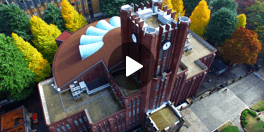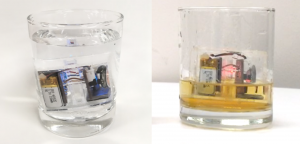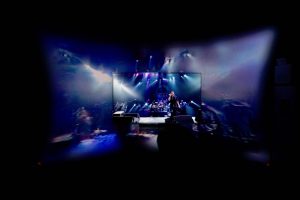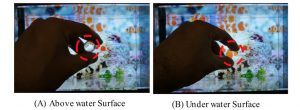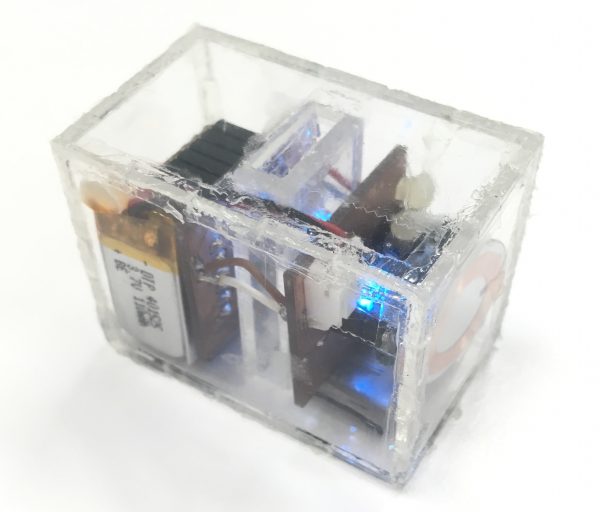
June 21, 2018
受賞報告Award Report
学府の学生が下記の賞を受賞しました!
情報処理学会第58回ユビキタスコンピューティングシステム研究発表会(website)にて優秀論文賞を受賞 松井秀憲さん(修士1年、矢谷研究室)
松井秀憲、橋爪崇弘、矢谷浩司「飲料のアルコール濃度計測を行うスマートアイスキューブの試作と評価」(受賞日:2018年5月18日)
論文概要・受賞コメント
近赤外・可視光LEDと光検出器を搭載し、水とアルコールの光吸収特性を利用してアルコール濃度計測を行うスマートアイスキューブを作成しました。本研究で作成したプロトタイプは3 x 4 x 5 cmの直方体で、このデバイスを氷のようにグラスの中に入れるだけで、通常の飲酒行為を妨げることなく濃度が計測できます。このデバイスは、ユーザに光フィードバックを与えることで、飲酒ペースの抑制、お酒を飲めない人のためのアルコール検出、カクテルの作成支援といったアプリケーションを実現します。今回の受賞を励みに、Human-Computer Interactionの分野においてさらなる研究活動に打ち込んでいきたいと思います。
・2018年8月2日、ワールドビジネスサテライト「トレンドたまご」(テレビ東京)に取り上げられました(8月7日追記)
写真(左上):プロトタイプが飲料のアルコール濃度を計測している様子
国際学会ACM CHI 2018(website)にてHonorable Mentionを受賞
木村直紀さん(修士2年、暦本研究室)
Naoki Kimura, Jun Rekimoto, ExtVision: Augmentation of Visual Experiences with Generation of Context Images for a Peripheral Vision Using Deep Neural Network, CHI ’18 Proceedings of the 2018 CHI Conference on Human Factors in Computing Systems (受賞日:2018年4月21日)
論文概要
ExtVisionは、周辺視野映像を生成し投影することで映像視聴体験を拡張するシステムです。中心視野だけでなく周辺視野に対しても映像を提示し視界を埋めつくすことは、没入感や臨場感、迫力といった視聴効果を増幅するために最も効果的な手段の一つですが、周辺視野映像を用意することが難しいという課題がありました。ExtVsionでは一般的な規格で撮影された映像を用意するだけで周辺視野映像を生成することができます。畳み込みニューラルネットワークを用いた画像生成モデルであるDCGAN(Deep Convolutional Generative Adversarial Networks)をベースとした手法により、入力された一般的な規格の映像に対して、写っている部分の外側の風景を予測生成し周辺視野映像として補完します。
写真(右上)
国際学会AH2018(website)にてBest Paper Awardを受賞
山下聖悟さん(博士2年、暦本研究室)
Shogo Yamashita, Shunichi Suwa, Takashi Miyaki, Jun Rekimoto, “Investigation of Tracer Particles Realizing 3-Dimensional Water Flow Measurement for Augmented Swimming Training”, the 9th Augmented Human International Conference(AH2018), February 2018, No. 2, 9 pages. (特許出願番号:特願2018-12298)
論文概要
国際学会AH2018では、水泳プールなど、人が存在する広域な環境において水の流れの3次元計測を可能とする新たな技術に関する検証について発表しました。本技術には、水泳トレーニング効率の向上などの効果が期待されます。また、人が水中に入って楽しむようなプール型のエンターテイメント環境において、水の流れを考慮したインタラクティブな映像コンテンツを実現することが出来ます。本研究成果は、JST ACT-Iの支援を受けたものです。
国際学会ACI2017にてBest Paper Awardを受賞
山下聖悟さん(博士2年、暦本研究室)
Shogo Yamashita, Sunichi Suwa, Jun Rekimoto, “AquaPrism: Dynamically Changing the Color of Aquatic Animals without Injury by Augmenting Aquarium”, The 4th international conference on Animal-Computer Interaction(ACI2017), November 2017, No.11, 9 pages. (特許出願番号:特願2018-095554)
論文概要
色鮮やかな観賞魚をペットとして飼育するアクアリウムは、古くから親しまれるリラクゼーションです。アクアリウムにおいて問題視されている事項の一つとして、色鮮やかな観賞魚は管理が困難である場合が多いため、代わりに、飼育の容易な観賞魚が蛍光塗料の注入やタトゥーなどより着色されて販売されていることがあります。これらの彩色手法は観賞魚に健康被害を与えることが明らかにされています。ACI2017では、観賞魚を傷つけることなく、体の色や模様を視覚的に自由に変化させる技術を提案しました。本研究では、偏光角がお互いに直行した偏光板を水槽の前面と背面に貼り付け、背後にディスプレイを設置しました。透明な観賞魚の体は、偏光した光を無偏光に変化させるため、水槽背後の景色が観賞魚を通して透けて見えます。背景の映像を変えることで、観賞魚の色や模様は視覚的に変化させることが出来ます。
編集:鳥海希世子(特任助教、ウェブサイト&ニューズレター編集部)
This is an award report received by the GSII students!
Excellent Paper Award at the 58th Presentation of Research of IPSJ SIGUBI(website)
Hidenori Matsui (M1, Yatani Lab)
Hidenori Matsui, Takahiro Hashizume, Koji Yatani “Designing a Smart Ice Cube with Beverage Alcohol Concentration Sensing” (Award received on May 18, 2018)
Paper Abstract & Comments
We develop a smart ice cube which can sense alcohol content of a beverage. It uses invisible and visible light for measuring the alcohol concentration level. As our device is small enough, a user can simply put it into a glass for measurements. The novelty lies in demonstrating alcohol concentration sensing suitable for daily use. Our evaluation also found that the device can accurately infer alcohol concentration levels without needing to prepare a beverage-dependent model. This award motivates me to work harder on Human-Computer Interaction research in my Master program.
Photo(top left):Measuring alcohol concentration level by the prototype
Honorable Mention at ACM CHI 2018(website)
Naoki Kimura (M2, Rekimoto Lab)
Naoki Kimura, Jun Rekimoto, ExtVision: Augmentation of Visual Experiences with Generation of Context Images for a Peripheral Vision Using Deep Neural Network, CHI ’18 Proceedings of the 2018 CHI Conference on Human Factors in Computing Systems (Award received on April 21, 2018)
Paper Abstract
ExtVision is a system to augment visual experiences by generating and projecting images for peripheral vision. Peripheral projection is one of the most effective techniques to enhance visual experiences. However, projection is still not commonly used because of the difficulty in preparing the images for peripheral vision. ExtVision generates images for peripheral vision from images shot with general standards, using a method based on DCGAN (Deep Convolutional Generative Adversarial Networks), which predicts and generates the landscape outside the input images and extrapolates it as images for peripheral vision.
Photo(top right)
Best Paper Award at AH2018(website)
Shogo Yamashita(D2, Rekimoto Lab)
Shogo Yamashita, Shunichi Suwa, Takashi Miyaki, Jun Rekimoto, “Investigation of Tracer Particles Realizing 3-Dimensional Water Flow Measurement for Augmented Swimming Training”, the 9th Augmented Human International Conference(AH2018), February 2018, No. 2, 9 pages. (Patent application number: 2018-12298)
Paper Abstract
Previous studies have revealed that understanding the 3D movement of water contributes to improving propulsion in the water when swimming. Fluid measurements are made by scattering tracer particles into a liquid, and cameras track the movement of these particles to measure the fluid’s flow. Strong lasers illuminate tracer particles to make them visible to cameras, but 3D water flow measurements in wide spaces like swimming pools have not yet been successful. This can be owed to the limitations of current optical systems impacting the measurable parameters of existing methods, such as the laser capacity and lens size. Moreover, visualized tracer particles buoyed in swimming pools can affect the swimmer’s view and may be harmful to humans when swallowed. Therefore, we propose a 3D water flow tracing technology with tracer particles suitable for a swimming pool. We use an optical property called optical rotation to track the tracer particles. This method would be effective in extending the measurable area of water flow than previous methods because it does not require the use of optical systems, which are technically difficult to expand. In this study, we investigated the materials and processing methods for creating tracer particles for augmented swimming training.
Best Paper Award at ACI2017
Shogo Yamashita(D2, Rekimoto Lab)
Shogo Yamashita, Sunichi Suwa, Jun Rekimoto, “AquaPrism: Dynamically Changing the Color of Aquatic Animals without Injury by Augmenting Aquarium”, The 4th international conference on Animal-Computer Interaction(ACI2017), November 2017, No.11, 9 pages. (Patent application number: 2018-095554)
Paper Abstract
Aquarium has attracted people since ancient times. It helps to create a relaxing, soothing environment just about anywhere people put them. Keeping beautiful aquatic animals in a fish tank at home is not always feasible. As a result, ornamental aquarium fish have been artificially colored by a hypodermic syringe containing a bright fluorescent color dye to appeal to consumers. A survey carried out in 1998 revealed that over 40% of painted fish showed signs of virus infection, compared to 10% of unpainted fish. We propose an augmented aquarium that dynamically changes the colors of translucent aquatic animals without injury. This technology produces colored and glowing aquatic animals in the dark in a standard fish tank at home.
Editing: Kiyoko Toriumi (Project assistant professor, Website & Newsletter Committee)

